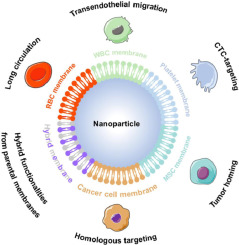当前位置:
X-MOL 学术
›
Acta Biomater.
›
论文详情
Our official English website, www.x-mol.net, welcomes your
feedback! (Note: you will need to create a separate account there.)
Cell membrane-camouflaged nanoparticles as drug carriers for cancer therapy.
Acta Biomaterialia ( IF 9.4 ) Pub Date : 2020-01-28 , DOI: 10.1016/j.actbio.2020.01.036 Cheng-Hui Xu 1 , Peng-Ju Ye 1 , Yang-Chun Zhou 1 , Dong-Xiu He 1 , Hua Wei 1 , Cui-Yun Yu 1
Acta Biomaterialia ( IF 9.4 ) Pub Date : 2020-01-28 , DOI: 10.1016/j.actbio.2020.01.036 Cheng-Hui Xu 1 , Peng-Ju Ye 1 , Yang-Chun Zhou 1 , Dong-Xiu He 1 , Hua Wei 1 , Cui-Yun Yu 1
Affiliation

|
The translocation of natural cell membranes to the surface of synthetic nanoparticles, which allows man-made vectors to share merits and functionalities created by nature, has been a hot subject of research in the past decade. The resulting biomimetic nanoparticles not only retain the physicochemical properties of nanomaterials, but also inherit the advantageous functions of source cells. Combined with the preponderances of both synthetic and natural platforms, the optimized biomimetic systems can maximize the drug delivery efficiency. In this review, we first summarize the preparation strategies of the biomimetic systems from the perspective of the correlation between the properties of nanoparticles and cell membranes. Six types of cell membrane-camouflaged nanoparticles are further introduced with an emphasis on their properties and performance. Finally, a concluding remark regarding the primary challenges and opportunities associated with these nanoparticles is presented. STATEMENT OF SIGNIFICANCE: Translocation of natural cell membranes to the surface of synthetic nanoparticles has been repeatedly highlighted in the past decade to endow man-made vectors with merits and functionalities created by nature; therefore, the resulting biomimetic systems not only retain the physicochemical properties of nanomaterials but also inherit the biological functions of source cells for efficient drug delivery. To provide a timely review on this hot and rapidly developing subject of research, this paper summarized recent progress on the cell membrane-camouflaged nanoparticles as drug carriers for cancer therapy, and focused primarily on six different types of cell membrane-coated nanoparticles with an emphasis on the preparation strategies from the perspective of the correlation between the properties of nanoparticles and cell membrane.
中文翻译:

细胞膜伪装的纳米颗粒可作为癌症治疗的药物载体。
在过去的十年中,天然细胞膜易位到合成纳米颗粒的表面,使人造载体可以共享自然界创造的优点和功能,一直是研究的热点。所得的仿生纳米颗粒不仅保留了纳米材料的物理化学性质,而且还继承了源细胞的有利功能。结合合成平台和天然平台的优势,优化的仿生系统可使药物递送效率最大化。在这篇综述中,我们首先从纳米颗粒和细胞膜的性质之间的相关性角度总结了仿生系统的制备策略。进一步介绍了六种类型的细胞膜伪装的纳米颗粒,重点是它们的性质和性能。最后,总结了与这些纳米颗粒相关的主要挑战和机遇。意义声明:在过去的十年中,天然细胞膜易位到合成纳米颗粒的表面已被反复强调,以赋予人造载体以自然创造的优点和功能。因此,所得到的仿生系统不仅保留了纳米材料的物理化学特性,而且还继承了源细胞的生物学功能以实现有效的药物输送。为了及时对此热门且迅速发展的研究主题进行回顾,本文总结了细胞膜伪装纳米颗粒作为癌症治疗药物载体的最新进展,
更新日期:2020-01-29
中文翻译:

细胞膜伪装的纳米颗粒可作为癌症治疗的药物载体。
在过去的十年中,天然细胞膜易位到合成纳米颗粒的表面,使人造载体可以共享自然界创造的优点和功能,一直是研究的热点。所得的仿生纳米颗粒不仅保留了纳米材料的物理化学性质,而且还继承了源细胞的有利功能。结合合成平台和天然平台的优势,优化的仿生系统可使药物递送效率最大化。在这篇综述中,我们首先从纳米颗粒和细胞膜的性质之间的相关性角度总结了仿生系统的制备策略。进一步介绍了六种类型的细胞膜伪装的纳米颗粒,重点是它们的性质和性能。最后,总结了与这些纳米颗粒相关的主要挑战和机遇。意义声明:在过去的十年中,天然细胞膜易位到合成纳米颗粒的表面已被反复强调,以赋予人造载体以自然创造的优点和功能。因此,所得到的仿生系统不仅保留了纳米材料的物理化学特性,而且还继承了源细胞的生物学功能以实现有效的药物输送。为了及时对此热门且迅速发展的研究主题进行回顾,本文总结了细胞膜伪装纳米颗粒作为癌症治疗药物载体的最新进展,













































 京公网安备 11010802027423号
京公网安备 11010802027423号